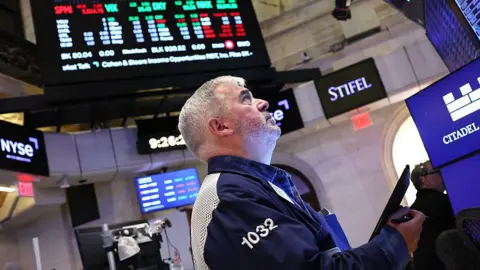In a significant resurgence following recent economic turbulence, Wall Street stocks have rebounded from the losses experienced after President Donald Trump implemented global tariffs about a month ago. This turnaround culminated in what marks the longest winning streak for U.S. stocks in two decades, with market gains observed for an impressive consecutive nine days—the first such occurrence since 2004. The surge in stock performance can be attributed primarily to a favorable jobs report released during the week and renewed optimism regarding potential trade negotiations between the United States and China.
As the markets closed on Friday, major U.S. indexes recorded notable increases. The S&P 500 and the Nasdaq both reported a rise of 1.5%, while the Dow Jones Industrial Average followed closely with a climb of 1.4%. A prominent contributor to these gains was the technology sector, which saw substantial increases with leading corporations, including Microsoft and Nvidia, witnessing stock price increases exceeding 2%.
Adding to this upward trend, the U.S. Department of Labor announced on the same day that employers had added approximately 177,000 new jobs throughout April. This figure exceeded analyst expectations, even though it reflected a slowdown in hiring compared to the previous month. Despite this deceleration, the unemployment rate remained steady at 4.2%, highlighting a generally resilient employment landscape.
The enthusiasm in the market was further buoyed by news from Beijing concerning its consideration of a U.S. proposal for trade discussions. Notably, China currently confronts the highest import taxes worldwide, assessed at a staggering rate of 145%. As such, hopes for diplomatic engagement have notably brightened, allowing investors to breathe a little easier in what has been a turbulent economic climate, especially since recent data from the commerce department indicated a contraction in the U.S. economy for the first time in three years.
Prominent economists provide varied perspectives on the current economic conditions. Carl Weinberg, the chief economist at High Frequency Economics, expressed positivity in his analysis, noting, “There is nothing to complain about here.” He added that the jobs figures do not indicate an impending recession. Similarly, Seema Shah, the chief global strategist at Principal Asset Management, noted that while an economic slowdown is expected in the coming months, the underlying positive momentum could afford the U.S. a chance to avert a recession—provided tariff tensions are resolved in a timely manner.
Conversely, some experts caution that the real implications of Trump’s tariffs may take time to surface fully. Olu Sonola, head of U.S. economic research at Fitch Ratings, remarked that, despite the strong jobs report, the economic outlook remains “very uncertain.” Such sentiments reflect the ongoing complexities and interdependencies in global trade dynamics that continue to affect market stability.
In summary, Wall Street’s recent recovery showcases a resilience in the face of economic challenges posed by tariff policies and broader trade uncertainties. The jobs report, signaling positive employment trends, alongside the prospect of U.S.-China trade talks, has rejuvenated market confidence. However, the lingering effects of tariffs and global economic conditions highlight the need for continued monitoring and analysis as investors navigate these potentially turbulent waters. Ultimately, will the sustained positivity outweigh the concerns that linger just below the surface? The coming weeks and months may provide crucial insights into this question.



